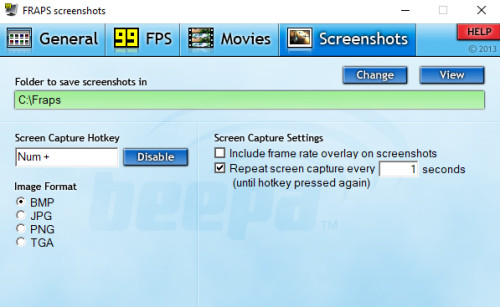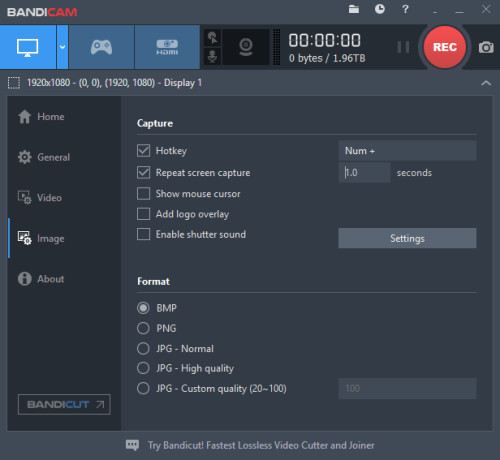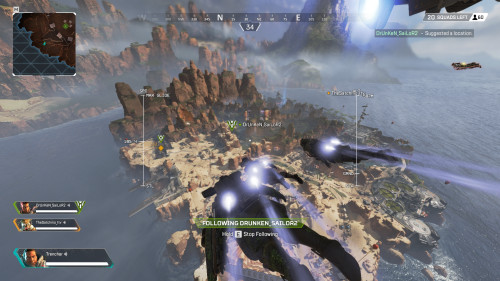When Alien: Isolation came out I was happy to see that Creative Assembly’s promises of delivering a game that recreated the look of the first Alien movie were actually kept. Still, I’ve never been a huge survival horror fan, and once reviews started coming in, talking about its long length and pacing issues, my interest waned. As time went on, however, it seemed like there were a lot of pockets of love and support for the game out there. People on podcasts I listened to and in articles I’d read talked about it being their game of the year, sometimes even on their short lists of favorite games ever. Eventually I couldn’t ignore the hype and vowed to play the game after all. Mentioning this to my partner, she soon began a campaign of peer pressuring me to play it so that she could watch and bask in my misery. Honestly, I was far more intimidated by its length than the scares, but eventually it felt like the time was right to commit to the 20+ hours, and dove in.
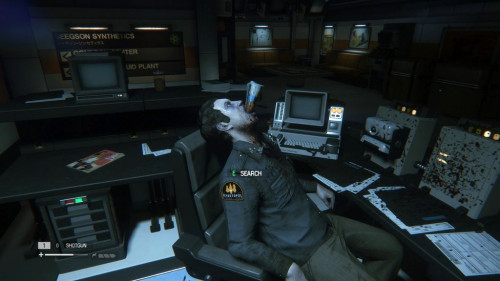
“Welcome to Sevastopol…”
First in foremost, as touted, the game is absolutely beautiful. The style and feel of the original 1979 Alien movie were lovingly recreated and, without direct side by side comparisons, seems quite faithful. I especially love the bizarrely retro-future feel of the computers, with their monochrome displays and multitude of lights, knobs, and bizarre noises. Sevastopol station, where you’ll be spending the majority of the game, reminds me a weird combination of the UAC facilities of Doom 3 and BioShock’s Rapture. Maybe that says more about the Aliens franchise’s influence on those games than anything, but I’d call that high praise regardless. The design is meticulously detailed, oh so eerie, and at times oddly claustrophobic. Helping with this immensely, the environmental lighting is great, with enough darkness to produce an intimidating mood without completely impeding the player’s ability to navigate. It all really works.
Alien: Isolation also nails it in the sound department. The sound effects are good all around, but the ambient noise is freakily eerie with the occasional suspicious noise thrown in just to keep you on your toes. Of course, if an enemy (particularly the alien itself) is stalking you, noise plays a big part in trying to track its location and activity. Hearing the alien clunking around as it moves through the vents above you never gets any less terrifying. The soundtrack is similarly well executed, incorporating some of the original movie soundtrack with more modern, electronic elements. It’s perfectly atmospheric, while at times dynamically shifting into a faster pace, crescendoing when the action peaks. Whether purposely or accidentally, sometimes these music changes seemed to be misleading which had me turning the tides on my girlfriend – on several occasions I looked over at her to see her nervously shielding her face in anticipation simply because the music had picked up which she thought meant I was about to be attacked. Hilarious!
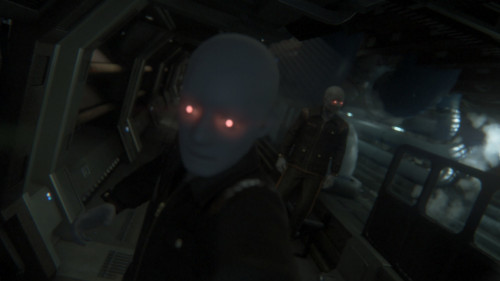
“Scary. Change my mind!”
The game starts out quite slowly, and the pacing just feels off to me for the first few hours. It takes quite a while before the alien even shows up, in fact. This actually lead to a little bit of unexpected tension, as I was constantly waiting for it to make its first appearance and needlessly psyching myself out. The game even seems to have a little fun with this at the player’s expense in places. That’s not to say there aren’t enemies, though. While the station is largely deserted, you’ll run into the occasional band of unfriendly humans and, much more infamously, androids. I heard a lot of people talk about the “Working Joe” androids, shrugging them off as boring and definitely not at all scary. Well, they’re wrong! Sure, the androids are MUCH more predictable than the more complicated AI tied to the alien, but with their glowing eyes, movements shifting from slow and freakily deliberate to fast and deadly, and their creepy speech, I thought they were plenty menacing.
Anyway, I digress. Let me backup and (vaguely) talk about the story. Amanda Ripley, the daughter of Ellen Ripley, the main protagonist of the original movies, learns that the flight recorder of the ship her mother was on in Alien, the Nostromo, has been recovered. She’s invited to travel to a distant mining station where it’s being held to learn more about her mother’s disappearance. When she gets there, well, let’s just say things aren’t going so great there. Shit gets crazy and Amanda learns more about what’s going on aboard Sevastopol station as well as more about the fate of the Nostromo along the way. The nice thing about the story is that it wedges itself between well known plot points in the first two movies without doing too much retconning, keeping it inoffensive to most franchise purists. The biggest complaints I can muster about it is that it feels a little extraneous and, perhaps, because of the length of the game, some of the plot twists and turns feel a little tedious.
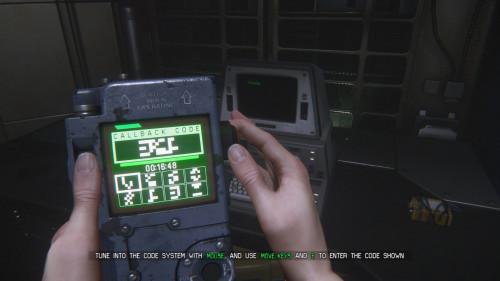
“Hack the planet! Hack the planet!”
The length and the pacing are (again) common complaints. I actually didn’t find the pacing to be nearly as bad as people made it out to be, after that initial slog I mentioned at least. It may just be that how intensely, nerve-wrackingly stressful the gameplay is to a lot of us also makes it feel a lot worse than it actually is, especially given the save system. Saving is done by static, manually activated save points scattered throughout the environment. For the most part they’re spaced just about perfectly to break the game down into relatively small, digestible sections. That said, given that you spend large portions of the game being actively hunted, and being caught usually results in death, the save system feels incredibly unforgiving and, at times, fucking infuriating. I’m 100% sure they went with this style of save system to up the tension, and it is slightly more flexible than hard checkpoints, I admit, but it definitely feels a bit of a dated design. Regardless of the pacing, I definitely agree with the common criticism that the game feels a lot longer than it should. There’s a fair degree of backtracking too. I get the impression that they were going for a sort of “metrovania” approach to gating content and it largely works, though that style of level design pairs badly with a game that already feels a little too long.
Beyond gating related items (the Maintenance Jack, the Plasma Torch, etc.) there are also a number of weapons and other items, most of which can be crafted from certain components found in the station. I personally found very few of these items useful enough to keep using. The Medkit, of course, ended up being pretty essential, particular in certain areas, and the Stun Baton is a godsend against rampaging androids, but otherwise? Eh. I know this is going to vary greatly by person, but this honestly didn’t feel like a playstyle thing – those items just didn’t feel all that useful to me, period. Normally when I play a game with a lot of options and I don’t use them all, I can at least see the potential in them. The whole thing is just… odd.
It’s especially odd in the case of weapons. It takes you awhile to find one, and when you finally pick up your first revolver it feels damn empowering. Then you go to use it the first time and discover that it’s probably a good thing you’ve had up until then to get used to playing without them. The shotgun is a lot better, but by the time you get it you’ll probably find yourself reluctant to use your trigger finger for a host of other reasons.
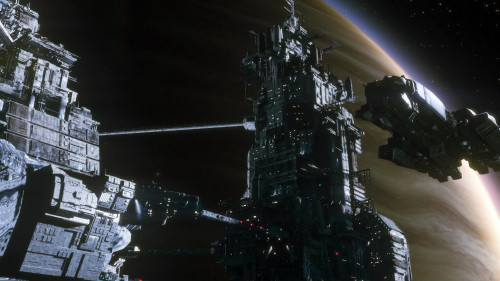
“The Torrens and Sevastopol Station.”
The biggest exception to this is the aforementioned creepy androids which, when they turn on you, take quite a beating until you nail them with a Stun Baton or catch them with an EMP blast. Of course, right around the time I felt like I mastered facing off with them you’re introduced to the Hazardous Environment Joes which are pretty much invulnerable to all of that stuff. I found myself in at least a couple of situations where I was stuck with a room full of these bastards and no great way to defeat them. This lead to some very creative (and very tense) trial and error situations that I somehow eventually myself through. It’s worth noting that you will eventually get the Bolt Gun which takes down either sort of android with a single clean headshot, though landing that shot under the kind of intense situations you’ll most want to use it in isn’t always easy, and the gun comes with a punishing reload time.
Dealing with the Working Joes is a walk in the park compared to dealing with our titular alien friend, however. Nothing is all that effective against the alien save for the flamethrower which you get in the last half of the game. It’s often mentioned that the flamethrower makes the game instantly easy, though I didn’t find that to be the case at all. Fuel (ammo) for the flamethrower is limited enough that you’ll want to use it sparingly, and you’ll run into the alien enough, even when playing extremely cautiously, that you’ll burn through it quite quickly if you start to rely on it. That, and it usually only scares the alien off for a short amount of time. While it does undeniably change the game a bit, it still remains tense, and if you do run out of fuel you’ll be faced with a whole new feeling of helplessness.
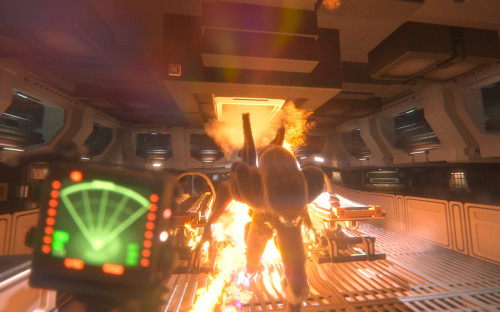
“The motion scanner is extremely useful at times. This isn’t one of them.”
The topic of the alien itself really deserves a lot of attention. As mentioned, it takes awhile for it to become a factor, but when it does… oof! The game uses some interesting AI scripting for the alien that makes it behave in some pretty unique ways. It’s utterly ridiculous – mostly ridiculously cool, but sometimes ridiculously cheap and unforgiving. I quickly learned a few tricks to allow me to adapt to being stalked by it, or really, just existing in a world where it also happens to be, which is scary enough, but it never really failed to feel like an existential threat, keeping me on the edge of my seat. I did get a little desensitized by the end of the game, but that had a lot less to do with the game’s tricks wearing thin on me, and more to do with having to constantly force myself to resist my cautious nature and adopt a “let’s do it!” attitude to accomplishing my goals that Leeroy Jenkins would be proud of. It’s far too tempting to sit around waiting until you feel safe, but those moments rarely come, and even when they do they’re usually a bit of an illusion. In short, waiting around is rarely beneficial to you – you just need to keeping pushing ahead onto the next area, that next objective, and the next story beat.
Like I said, as amazingly cool as the alien’s behavior could be at times, it could also really suck. There were plenty of quirks in its scripting resulting in kills that felt amazingly cheap and unfair and some generally annoying patterns of behavior, such as the realization that you’re on this massive space station but no matter where you are, the alien always seems to be coming after you and you alone. It doesn’t matter where you are, where you’ve gone, or what else is around, it’s like its tethered to you, which definitely ruined a lot of the immersion for me. As such, I also wish there were more moments of the alien interacting with other humans and, despite some plot points against it, the androids. There are some other minor issues with the game too, like how the auto-map largely feels like it was an afterthought and how some other elements of the UI don’t feel like they spent enough time in the hands of the UX team.
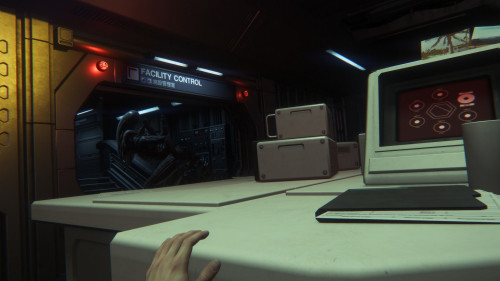
“The majority of xenomorph encounters go more like this…”
Despite all of this, there’s no doubt in my mind that Creative Assembly managed to make a compellingly terrifying experience. Before playing Alien: Isolation, I think the scariest game I ever played was Doom 3. That game was all about tension though – never knowing when the next monster would pop out of a deviously placed “monster closet” to achieve a cheap jump scare. This game, on the other hand, had all of that and more – an incredible atmosphere and an almost palpable feeling of dread at times – I mean, it had me literally yelling out loud multiple times throughout my playthrough. Sure, some of this was me just getting into the spirit of it, which was even funner with my girlfriend just as freaked out by watching me play as I was playing, but this was genuinely a first for me.
There’s probably a lot more I could say, but in the spirit of avoiding too many spoilers and encouraging people to try it themselves, I’ll just wrap up by saying that Alien: Isolation is a great game that more people should play. Should you play it? It’s hard for me to recommend this kind of game in any sort of universal way, given how subjective the enjoyment of these types of games can be. For me, it’s a bit of a love and hate situation, with love undeniably winning out at the end of the day. It’s certainly my new favorite survival horror game, but with the length and odd annoyances added to how nerve wracking the whole thing was for me, I have no plans to check out the DLC any time soon and I highly doubt I’ll ever play through the main campaign again despite how much I ultimately enjoyed the experience.
In the future I will be shoved out of an airlock for my stealing the above screenshots from random sites around the web. Please, just make it quick.
